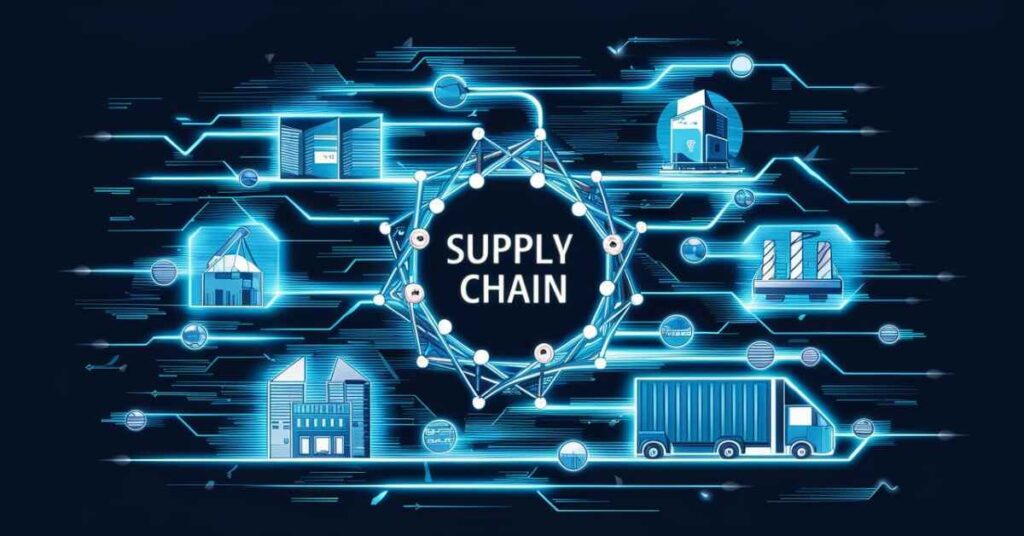In today’s intricate global supply chains certifying transparency and traceability has become a massive challenge. From fake goods inundating the market to products evoked due to contamination.
The vulnerabilities of our current systems are glaring. However, an inventive technology is emerging as a prospective game changer blockchain. This dispersed ledger technology is poised to update supply chain management by providing extraordinary visibility and reliability to logistics procedures.
Understanding Blockchain’s Role in Supply Chain Transparency
Before delving into the applications of blockchain in supply chain management, it’s difficult to understand what this technology involves. Simply put a blockchain is a decentralized digital register that records relations across several computers in a complex. It’s like a shared database that is frequently updated and authenticated by all applicants without the need for an essential ability.
Imagine a situation where multiple parties are cooperating on a project. Each contributes their part to a shared text. With a traditional centralized system, there would be a single point of control. Making it vulnerable to management or failure. However, in a blockchain network, every applicant has a copy of the document any changes made are suddenly reflected and confirmed across all duplicates ensuring data integrity and limpidity.
Key Benefits of Blockchain in Supply Chain Transparency:
- Immutability: Records on the blockchain cannot be altered, providing an immutable audit trail.
- Decentralization: No single entity controls the data, promoting trust and transparency.
- Cryptographic Security: Advanced encryption techniques secure the network and transactions.
By addressing disputes like fake goods lost inventory product recalls. Blockchain technology has the prospective to change supply chain operations fostering greater trust and collaboration effectiveness among all participants.
Tracing the Path: Applications of Blockchain in the Supply Chain

The uses of blockchain in supply chain management are vast and diverse. Covering various industries and sectors. From food and beverage traceability to virtuous obtaining and fair employment verification. This technology is composed to transform the way we track and monitor the movement of things.
Food and Beverage Traceability
The most prominent use case of blockchain in supply chain management is in the food and beverage industry. With developing consumer demand for limpidity and accountability companies are revolving to blockchain to provide an absolute record of a product’s journey from farm to fork.
Walmart’s efforts in leveraging blockchain technology to track its pork and harvest supply chains. By joining with IBM’s Food Trust platform, Walmart can now trace the cause of a package of mangoes in just 2.2 seconds. A process that before took nearly seven days. This level of traceability not only augments food safety but also allows for sudden ID and containment of any possible contamination matters.
Pharmaceutical Supply Chain Integrity
Another serious application of blockchain lies in the pharmaceutical industry. Where retaining the honesty of the supply chain is a matter of life and death. Imitation drugs pose a Spartan risk to public health blockchain technology can help moderate this threat by ensuring end-to-end traceability and faithfulness.
Companies like Modum.io are leveraging blockchain to monitor the environmentally friendly conditions of temperature-sensitive pharmacological products throughout transportation. By joining blockchain with Internet of Things (IoT) sensors. They can track and record temperature humidity and other critical data points ensuring product quality and compliance with controlling values.
Ethical Sourcing and Fair Trade Verification
Beyond traditional supply chain pursuing, blockchain is also being traveled as a means to verify the moral sourcing of goods and stimulate fair trade practices. By providing an unchallengeable record of a product’s journey. Blockchain can ensure that workers are paid fair wages resources are sustainably sourced environmental values are upheld.
Projects like the Blockchain for Good advantage by the United Nations are leveraging this technology to authorize small-scale farmers and producers to certify they receive a fair share of the profits and promote transparency in supply chains.
Blockchain’s Promise: Boosting Operational Efficiency
Transparency and traceability are undoubtedly important benefits of blockchain in supply chain management. The technology also makes the possible to reorganize operations and enhance proficiency across various aspects of the logistics procedure.

Reducing Delays through Automated Smart Contracts
The most promising application of blockchain in supply chain management is the use of smart agreements. These self-executing contracts can automate procedures reduce delays and minimize the need for arbitrators.
For example, when a consignment arrives at its destination the smart contract can automatically initiate payment to the dealer upon verification of delivery eradicating the need for manual billing and payment handling. This not only saves time and decreases the risk of errors but also raises trust among all parties involved.
Streamlining Compliance and Customs Processes
Another area where blockchain can drive working efficiency is in the realm of compliance and customs courses. By providing a secure absolute record of transactions blockchain can streamline the certification and verification procedures required for cross-border trade.
Companies like TradeLens, a joint project between Maersk and IBM, are already leveraging blockchain technology to ease more effective and safe global trade. By digitizing and streamlining delivery procedures. TradeLens aims to enhance transparency and decrease the organizational burden associated with cross-border logistics.
Cutting Costs by Removing Third-Party Intermediaries
Traditional supply chain operations often include multiple mediators such as brokers banks and other third-party service workers. These mediators not only add complexity but also growth costs for all parties involved.
Blockchain technology has the possible to disrupt this pattern by allowing direct peer-to-peer trades and reducing the need for intermediaries. By eliminating these middlemen, businesses can significantly cut charges and improve their supply chain processes.
Enhanced Inventory Management and Forecasting Accuracy
Leveraging the translucent and real-time data provided by blockchain supply chain managers can gain unprecedented visibility into inventory levels, demand patterns and supply chain dynamics. This treasure of data can be leveraged to improve inventory managing reduce stockouts and overstocking improve forecasting correctness.
By mixing blockchain with advanced analytics and machine learning algorithms businesses can unlock valuable insights and make data driven choices to simplify their supply chain operations resulting in cost savings and improved customer satisfaction.
Read this Blog: Pursuing Rewarding Careers in Procurement with a Supply Chain Management Degree
Overcoming Obstacles: Challenges in Blockchain Adoption
While the prospective benefits of blockchain in supply chain management are undeniable. It’s essential to acknowledge the challenges and difficulties that impede widespread approval of this technology.

The “Chicken and Egg” Problem of Getting All Parties on Board
One of the most significant challenges in applying blockchain solutions in supply chain management is the “chicken and egg” problem. For a blockchain network to function effectively. It requires widespread adoption and membership from all participants involved in the supply chain.
Considerable multiple festivities with varying interests and levels of scientific maturity to implement a new disruptive technology can be a daunting job. Some may be diffident due to the apparent complexity or disquiets over data privacy and refuge.
Integrating Blockchain with Existing Legacy Systems
Another significant hurdle in the approval of blockchain technology is the addition with existing legacy systems and structure. Many organizations have invested greatly in their current supply chain management systems, and flawlessly incorporating blockchain solutions into these recognized systems can be a complex and costly effort.
Organizations may need to assume a phased approach, increasingly assimilating blockchain solutions into explicit aspects of their supply chain operations. Additionally, the growth of robust application programming interfaces (APIs) and middleware solutions can enable smoother addition between blockchain networks and legacy schemes.
Standardization and Interoperability between Blockchain Solutions
With multiple blockchain stages and procedures emerging ensuring standardization and interoperability between changed blockchain solutions is vital for extensive adoption in supply chain management. Lack of normalization can lead to crumbling hindering the seamless exchange of data and material across supply chain networks.
Industry-wide creativities and associations are working to address this challenge by evolving common standards and procedures. For example, the Blockchain in Transport Alliance (BiTA) is focused on building a blockchain framework that encourages transparency and trust in the transportation and logistics industries.
Navigating Regulatory Hurdles
As with any disturbing technology, the adoption of blockchain in supply chain management is not without controlling challenges. Different countries and areas have varying regulations and obedience requirements. Which can hinder the seamless implementation of blockchain results through global supply chains.
To navigate these controlling hurdles, close association between industry shareholders, blockchain developers. Regulatory experts is essential. By fostering open negotiations and sharing in the development of blockchain-specific regulations. Organizations can help shape a directing environment that supports innovation while certifying compliance and consumer safety.
The Road Ahead: What’s Next for Blockchain Supply Chains?
While the acceptance of blockchain in supply chain management is still in its early phases, the future holds electrifying possibilities and developing trends that could further improve the abilities and impact of this technology.

Emerging Trends: AI/ML Integration, Private/Consortium Blockchains
One of the most promising trends in the blockchain supply chain space is the mixing of artificial intelligence (AI) and machine learning (ML) expertise. By joining the transparent and incontrovertible data provided by blockchain with advanced analytics and analytical models. Organizations can unlock deeper visions and make more informed decisions.
For instance, AI algorithms could analyze historical supply chain data on the blockchain to identify patterns, predict demand fluctuations, and optimize inventory levels, leading to improved efficiency and cost savings.
Real-time Asset Monitoring through IoT and Blockchain Convergence
The meeting of blockchain technology with the Internet of Things (IoT) is controlled to transfigure supply chain observing and asset following. By integrating IoT sensors with blockchain networks groups can capture real-time data on the location condition and conservational issues surrounding their assets through the supply chain journey.
For example, temperature-sensitive pharmaceutical products could be watched continuously using IoT sensors. Figures securely recorded on the blockchain, providing an absolute audit trail and confirming compliance with quality values.
The Role of 5G and Edge Computing in Enabling Blockchain at Scale
As blockchain supply chain solutions become more prevalent and data-intensive, the need for robust and high-speed connectivity becomes progressively vital. The advent of 5G networks, with their low potential and high bandwidth abilities. It a pivotal role in enabling blockchain resolutions to operate at scale across global supply chains.
The rise of edge computing, where data handling and analysis occur closer to the source. It can enhance the presentation and receptiveness of blockchain-based supply chain presentations. By decreasing the need to transmit great volumes of data to central cloud servers. Edge computing can facilitate real-time decision-making and enhance supply chain operations.
Potential Future Use Cases across Industries
Current applications of blockchain in supply chain management are primarily attentive on industries like food and beverage pharmaceuticals ethical sourcing. The potential use cases are huge and span various areas. From tracking high value assets in the luxury goods industry to safeguarding obedience in the automotive supply chain. Blockchain technology holds the promise of transforming how we monitor and manage the flow of goods and supplies.
As the technology matures and implementation increases, we can expect to see original use cases emerge leveraging the unique capabilities of blockchain to address industry specific experiments and drive superior efficiency transparency trust throughout the supply chain ecosystem.
Conclusion
In the ever evolving landscape of global supply chain management, blockchain technology is emerging as a transformative force poised to address long-standing challenges and usher in a new era of transparency, traceability and operational efficiency. From food and beverage traceability to pharmaceutical supply chain integrity and ethical sourcing the applications of blockchain are vast and far-reaching.
By leveraging the core features of immutability, decentralization, and cryptographic security, blockchain provides an immutable audit trail that fosters trust and collaboration among all stakeholders involved in the supply chain.
However, the journey towards widespread adoption of blockchain in supply chain management is not without its challenges. Overcoming obstacles such as the “chicken and egg” problem of getting all parties on board, integrating with legacy systems ensuring standardization and interoperability and navigating regulatory hurdles will require concerted efforts from industry stakeholders blockchain developers, and regulatory authorities.


![Find a Section 8 houses for rent with no deposit Revealed! [2024]](https://busslirra.com/wp-content/uploads/2024/08/Find-a-Section-8-houses-for-rent-with-no-deposit-Revealed-2024-300x157.jpg)







![Find a Section 8 houses for rent with no deposit Revealed! [2024]](https://busslirra.com/wp-content/uploads/2024/08/Find-a-Section-8-houses-for-rent-with-no-deposit-Revealed-2024-150x150.jpg)
